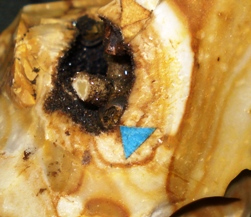
Catalogues
Alongside Sir John St. Aubyn’s Collection are several catalogues. In 1799, Babington published a catalogue titled A New System of Mineralogy. The catalogue, written using Baron Born’s Lavoisierian principles of new chemistry, describes approximately 2000 minerals. This catalogue is important because it describes the minerals that Sir John bought from Babington in 1799, most of which were previously owned by the 3rd Earl of Bute.
Between 1794 and 1815, de Bournon arranged Sir John’s minerals so that they followed the crystal structure, as advocated by the Abbé Haüy. But de Bournon never completed his catalogue. We also believe that volume one is missing, which would have described 606 specimens of witherite, barytes, strontianite and quartz.
PCMAG also holds three other catalogues, written in English. One is very large and has pre-printed headings ‘Order, Species, and Case’ and covers Allan’s orders 1-11, so the second volume is missing. Alongside this is an index list of mineral names written in another hand in black ink. The book bears a stamp, indicating that it was bought from Thompson’s Commercial Stationers, Old Town Street, Plymouth. This part of Plymouth was severely bombed in the war, and so this book is likely to pre-date 1940. This index also only covers orders 1-11. Lastly, we have Mr Elliot Steele’s list of Devonport Minerals, written in pencil and pen, and a number of loose pieces of paper covering many audits over the years.
In recent years, there has been some ambiguity hanging over de Bournon’s catalogues, because both volumes were written in French. In 2008, Margaret Morgan (Royal Cornwall Museum) started translating two volumes. One year later, many minerals have been reunited with their French descriptions. Margaret was also able to unveil the mystery behind our triangular labels (picture). It was discovered that Count de Bournon used them as pointers to show something of interest on the specimen. Below is a translated quote where he describes the action of placing this distinctive label on a specimen:
“J’ai indiqué, par un petit morceau de papier bleu, un octaèdre très alongé de la pyrite blanche arsènicale, dont ce morceau enferme plusieurs octaèdres parfaits”.
[“I have indicated, by a small piece of blue paper, a very elongated octahedron of the white arsenical pyrites, of which this piece contains several perfect octahedrons” (De Bournon, 1815, pp.388).]
We have also discovered during the translation that a number of interesting essays were hidden within the catalogue. These essays are historically important because they were never published and they present de Bournon’s ideas about geology almost 200 years ago.